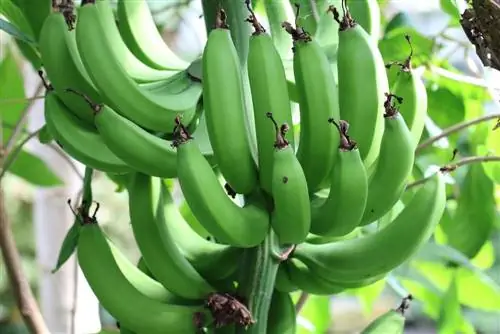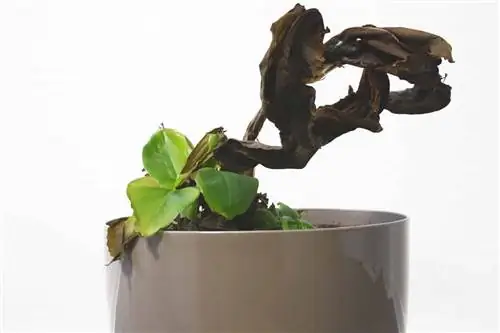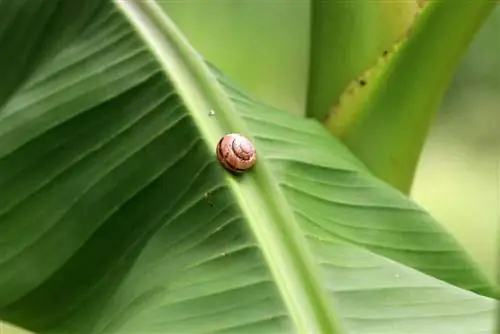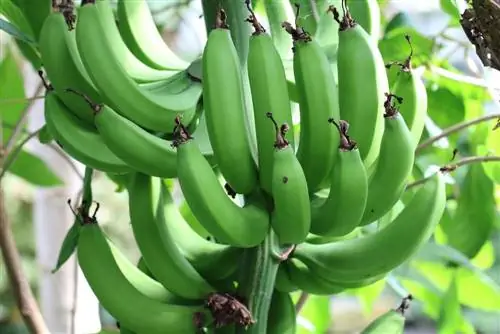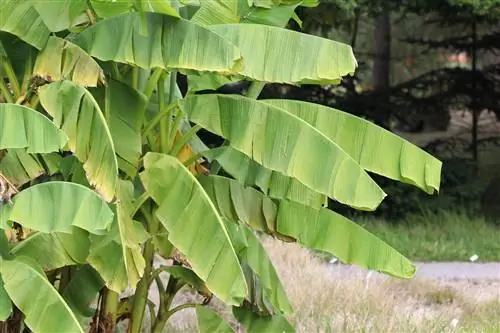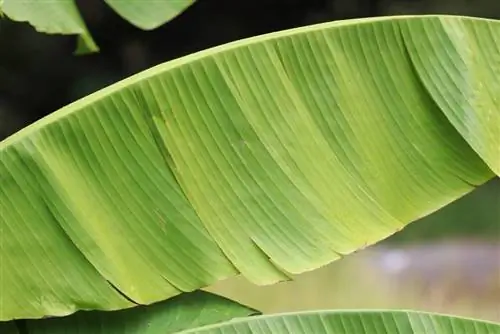- Author admin [email protected].
- Public 2023-12-17 03:39.
- Last modified 2025-01-24 12:45.
In order to properly overwinter a banana tree, the gardener must know what type of banana tree it is. The individual varieties have different requirements when it comes to overwintering. It is necessary to know these. There are around 70 different bananas (Musa). While bananas were previously grown purely as houseplants, more and more hobby gardeners are planting them in the garden in the summer. But how do you properly overwinter a banana plant in order to enjoy the plant for a long time?
Winter rest
It is important to know that generally all banana trees need a vegetation break of around three months once a year. This also includes houseplants. This should be taken into account if you want to overwinter the perennial, whether outdoors, in the basement or in the apartment. This requires slightly cooler temperatures than in summer. During the dormant phase, most banana plants lose their leaves.
Only perennials that have overwintered warmly retain their leaves but do not go into hibernation. Without this vegetation break, the plant will not grow vigorously again next spring, but will stop growing - at least for a few weeks or months. Although it looks bad when the leaves of the banana turn brown, it is not bad for the plant.
In general, three groups are distinguished.
- Bananas from temperate zones (so-called hardy perennials)
- Perennials from subtropical areas (cool overwintering)
- tropical banana trees (warm overwintering)
Of the approximately 70 known species of banana (Musa), almost all originally come from the tropical or subtropical region (Asia and the Western Pacific region).
Tropical banana trees
Tropical banana trees can be planted outdoors in the summer, but they must be dug up again in good time in the fall, planted in a planter and brought indoors. Wintering is incredibly easy. In general, banana plants that are overwintered indoors need a lot of light. However, in most cases, the heated living room is not the right place for a banana. The group of tropical bananas includes banana trees that come from Hawaii, Kenya and Southeast Asia, for example the Musa acuminata Dwarf Cavendish and the Musa Dwarf Red.
- the brighter, the better
- possibly install a plant light
- optimal temperature: 16 to 18 degrees
- always well above 10 degrees
- only water when the substrate comes away from the edge of the pot
- do not fertilize
- check regularly for pests
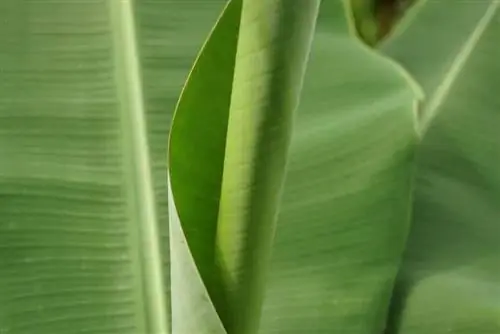
If banana plants are overwintered too warmly, they will not have a rest period during this time. The perennial then catches up on this in the spring. The result: the banana doesn't grow. Caution is also advised if the amount of water is too high, because despite the relatively high temperatures, the banana goes into hibernation. If the plant is too wet, it begins to rot and dies.
Subtropical species
Banana plants that come from subtropical areas, such as the ornamental bananas (Ensete ventricosum) with their strikingly red leaf midribs, can tolerate slightly cooler temperatures in winter than the tropical species. If the plants are outside in the garden or on the terrace in summer, they can simply be brought indoors in the planter when the temperatures outside fall below 5 degrees. The substrate should be well dried when stored, because nothing is more damaging to bananas in winter quarters than excessive moisture.
- Wintering: cool and dark
- unheated basement, garage
- ideal temperatures: around 10 degrees
- be sure to keep frost-free
- the cooler the area, the darker it can be
- water very cautiously
Tip 1
Specimens planted in the garden must be dug up in autumn and planted in a container so that they survive the winter. The leaves dry out during the winter, so they can be cut off either immediately or in spring. From mid-May the plants can be outdoors again.
Tip 2
Instead of overwintering the entire plant, you can also choose the space-saving option and only overwinter the rhizomes. These are the small offshoots that form on the sides of the base of the trunk.
- Dig up banana plant
- Carefully separate rhizomes from the mother plant
- place in a box with bark mulch
- cover with a damp cloth
- Store in a dark and cool place (5-10 degrees)
- Cloth must always remain slightly damp
Varieties from temperate climate zones (hardy varieties)
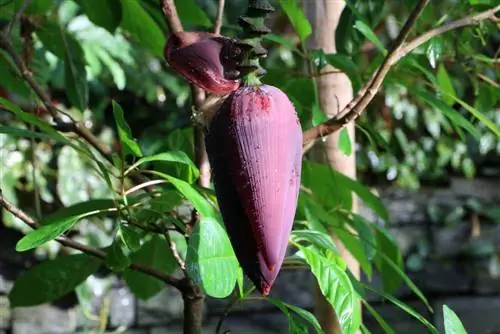
Some banana trees are also considered hardy. They originally come from warm temperate climates. A typical representative of the hardy banana plants is the Musja basjoo, the Japanese fiber banana. However, these plants are not really frost-resistant. In regions where the winter is not extremely long and cold, these perennials can be left outdoors. However, only in a suitable location and with the right winter protection.
This overwintering is suitable for the following banana plants:
- Musa basjoo (Japanese fiber banana)
- Musella lasiocarpa (Golden Lotus)
- Musa balbisiana (silver banana)
- Musa cheesmanii (Cheesman Banana)
- Musa itinerans (Blue Burmese Banana)
- Musa yunnanensis (Wild forest banana)
- Musa sikkimensis (Darjeeling banana)
Cutting
If the temperatures fall below 5 degrees in autumn, it is time to prepare the banana plant for winter. This time usually comes around the beginning of October, but depending on the weather conditions it can also be a little earlier or later. It's best to look at the current weather forecasts from the end of September so that you aren't suddenly surprised by the onset of winter.
Tip 3
Since the leaves cannot survive the cold temperatures anyway, they can be cut off when preparing for overwintering. In principle, it would be sufficient to overwinter just the offshoots of the banana plant. When the temperatures rise again in spring, the perennial begins to sprout new leaves from the rhizomes and form a long pseudo-stem. To do this, simply cut off the trunk in autumn. The height at which the trunk is cut depends on which insulation materials are available.
Variant 1: Rabbit fence
Fine mesh wire is usually available by the meter and is 50 cm wide. The height of the mesh fence limits the trunk height of the banana, as at least 20 cm of fence should remain above the cut. Four thick wooden posts with a diameter of one meter are driven into the ground and wrapped with fine-meshed wire (rabbit wire).
- Remove leaves
- Saw the trunk at a height of 20 to 30 cm
- drive four wooden slats into the ground
- If necessary, support rods for tomatoes are also sufficient
- Diameter of the frame: 80-100 cm (around the trunk)
- wrap with fine-mesh wire
Variant 2: Rain barrels
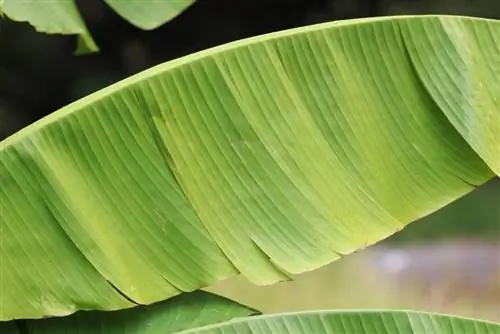
If you have an old rain barrel in your garden, you can also use it to protect the banana plant from winter. This is very easy because you just have to turn the barrel over and saw out the bottom. The barrel is then placed upside down over the sawn-off stump of the banana tree. Of course you can also buy a new rain barrel. These are available in any hardware store for 20 to 30 euros.
- Sawing the floor out of the rain barrel
- 200 liter bin: leave 80 cm trunk standing
- 300 liter bin: leave 100 cm trunk standing
- put it upside down over the banana
- Place wooden wedges, stones or slats under the barrel (for ventilation)
Advantages of both variants: little effort (less than 1 hour), low costs (around 30 euros)
Disadvantage: The banana will only reach a maximum size of around 2 meters the following year and never the full height of a normal, fully grown banana plant. This also means that it will probably never bloom and bear fruit.
Tip 4
Since the cut surfaces on the banana tree are usually very large, pathogens can penetrate the wound. It is therefore advisable to brush the interface with carbon powder before covering it.
Tip 5
The actual insulation layer consists of the filled leaves. In addition, the rabbit fence is wrapped with two to three layers of bubble wrap and stapled or tied. Then there are two more layers of wicker mats or something similar wrapped around it. The lower 10 cm are not wrapped with foil to ensure good ventilation.
Tip 6
The colder the winter, the more important the filling material is for winter protection. Although straw can be used as filling, the problem is that no significant heat is generated when the straw rots. And this is important if the banana is to survive in very cold winters. Straw is best suited to warmer regions. In cold areas it is better to use deciduous species that have very hard leaves, rot slowly and release heat, such as:
- Walnut leaves
- maple leaves
- Oak Leaves
Tip 7
Depending on the variant, a lot of leaves may be necessary to fill the winter protection. If you want to overwinter your banana in this way, you will need several cubic meters of foliage for large plants. This works best if you have appropriate leaf suppliers on your own or neighboring property or if you live close to the forest. So think about the filling material first and only then about overwintering outdoors.
Tip 8
The leaf layer should be tightly packed, but not pressed together with force. There should be at least 20 cm of leaves above the trunk. If the trunk is cut to 20 centimeters, a total of 40 to 50 cm of foliage is necessary. With a rain barrel, the leaves are piled up about one meter high.
Tip 9
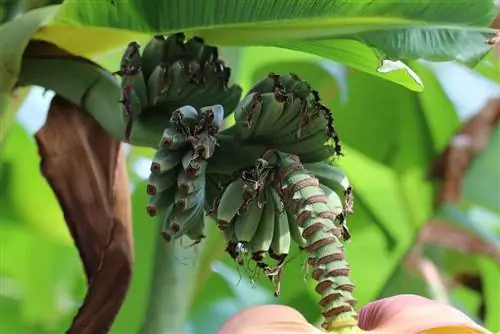
So that the banana plant does not get wet and rot, protection from rain and snow is necessary. This is ensured on the one hand by the bubble wrap covering and on the other hand by a lid that is placed on top. Depending on the variant, this can consist of the following materials:
- Styrofoam plate (with weight)
- Bucket or tub (upside down)
- thick wooden board
- large path plate (at rain barrels)
Tip 10
Insulation and rain protection must under no circumstances hermetically seal off the interior. The banana trees must be dry. Therefore, all covers must be constructed in such a way that the leaves can dry permanently even in winter. The barrel or the bubble wrap on the rabbit fence must not reach all the way down.
- Place the rain barrel on wooden blocks or bricks
- Do not insulate mesh fence in the lower 10 cm above the ground
Tip 11
The warmer the temperatures get in spring, the more often the airing takes place. Just don't forget to put the cover back on before it rains. During wintering, wetness is the most common reason - even before frost - for the death of the banana plant. From mid-May, when late frosts are no longer to be feared, the winter protection can be removed.
Ideal overwintering of hardy bananas
By far the most complex method is the following. But after a few years you will be able to experience your banana in all its splendor and size. If you're lucky, these plants will even bloom and bear fruit. This requires a little effort, but it is definitely worth it for true banana tree lovers. The leaves are only shortened to such an extent that about 10 cm of the petiole remains.
A slatted frame is built in the appropriate size and height (at least 20 cm higher than the banana plant). This is a lot of work in the first year, but the framework can be used for several years.
Material list for individual trunks (if there are several trunks, the construction must be larger):
- 4 square timbers, 7 x 7 x 210 cm
- 4 Floor drive sleeves for square timbers, 7 x 7 x 40 cm
- Roof battens (approx. 20 m in total)
- Bubble foil (bubble foil)
- Screws, screwdrivers
- Tackers and staples
- Saw
- depending on size and diameter around 25 metal angles and flat irons
- Rabbit Wire
Build basic structure
In contrast to the variant mentioned above, the banana can remain its entire size. Only the leaves are cut off at the base of the leaf and rubbed with charcoal. The impact sleeves are driven in around the banana plant, spaced 1 m apart. The squared timbers are then sawn to the correct length. This should be about 20 cm longer than the top edge of the banana tree.
Screw the square timbers to the sleeves and also connect them at the top and bottom with matching crossbars to create a cube. For stabilization, two to three crossbars are attached to each side, including on the top side of the roof. The crossbars can either be screwed directly onto the square timbers or using a metal angle or flat iron. It is advisable to lay the roof at a slight angle so that the rain can run off better.
Isolation
Several layers of bubble wrap are now stapled around the stable basic structure made of slats. On one side, a fine-meshed wire is attached to the bottom area instead of the film for better ventilation. Of course there is no foil on top of this. Leave a triangular window at the bottom on another side where the foil will not be stapled. This is to provide adequate ventilation on warm days by simply folding it to the side. Rabbit wire is placed under this window so that the leaves do not fall out when it is opened. The film is attached in this area with pinboard pins so that it can be easily opened at any time.
Always start attaching the foil at the bottom. Once the lower foils have been attached, the interior is first filled with leaves. Then continue to work your way up, filling up with leaves after each circle until you reach the roof. Then all you have to do is cover the roof with foil.
Conclusion
Overwintering varies depending on the origin of the banana plant. No matter what variety it is, the bananas need a three-month period of rest. In this it should be a little cooler. The most important thing is to keep the plant dry during this time so that it does not rot.

